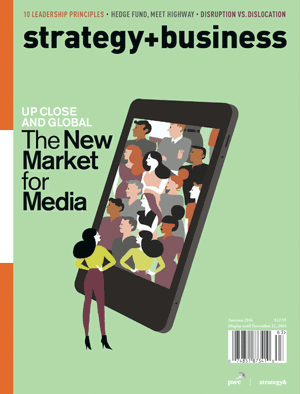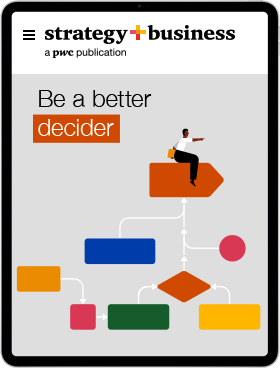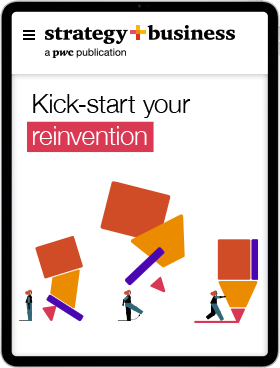Issue 84, Autumn 2016

Cover story
- Marketing, Media & SalesEntertainment and media companies can tap into many pockets of growth and opportunity. Our intensive analysis of five shifts roiling the industry can help you identify them.
In this issue
- Strategy & Leadership
10 principles of strategic leadership
How to develop and retain leaders who can guide your organization through times of fundamental change. - Innovation
Diagnosing Dislocation
Don’t assume the new entrant in your market is a disruption. Learn to recognize different types of threats and design the best strategic response. See also "Threatened by Dislocation." - Marketing, Media & Sales
You’re a Media Company. Now What?
Four strategies that work in this dynamic new world. - Marketing, Media & Sales
India’s Triple Play
What do feature phones, regional newspapers, and smartphones have in common? They’re all vehicles for the country’s remarkable move to digital broadband. - Marketing, Media & Sales
Fan Favorites
In order to build engagement and loyalty in a climate of intense competition and distraction, media companies have to understand their customers, viewers, and readers as fans.
Leading Ideas
- Marketing, Media & Sales
Fantasy-League Media
If you could draft an all-star team of entertainment and media assets and capabilities, who would you pick? - Thought Leaders
The Financial Insecurity Bias
Tuck professor Eesha Sharma on how perceptions of personal wealth affect the decisions people make. - Strategy & Leadership
Why Popular Strategies Always Fade
The most capable strategists see the real value, and big pitfalls, in new business concepts. - Finance
Why the Banking Industry Needs $600 Billion Worth of M&A
The case for consolidation in U.S. retail and commercial banking. - s+b BlogsBusiness Literature
How to Hijack Your Lazy Brain
In his new book, Charles Duhigg demonstrates that making the right choices is the key to boosting personal productivity.
Essays
- Technology
The chrysalis effect
Successful startups reach a point when they must shed their early habits and take on just the right amount of managerial maturity. - Finance
Hedge fund, meet highway
New investments in infrastructure by private asset managers are changing the way the world finances its cities, power systems, and transportation links.
Essays
- Marketing, Media & Sales
Sir Martin Sorrell of WPP on Coming Together
The firm’s CEO explains how the global agency is deploying its resources to connect effectively with clients and consumers across industry and geographic borders. - Marketing, Media & Sales
Facebook’s Carolyn Everson on Connecting at Scale
The company’s top marketing executive describes the social network’s ambitious efforts to forge enduring and meaningful relationships — with employees, industry partners, and everyone else on Earth.
Books in Brief
- Business Literature
Share and Share Alike
In his new book, Arun Sundararajan paints a rosy picture of the revolutionary companies and platforms that are altering the nature of work. - s+b BlogsBusiness Literature
How to Become a Talent Magnet
Superbosses examines the talent practices of those rare leaders whose protégés go on to dominate industries. - Business Literature
Nurturing Nature
In his new book, evolutionary biologist Joseph Henrich argues that culture and behavior can have an important impact on evolution. - s+b BlogsGlobal Perspective
Hamilton’s Place
Has American economic history proved that pragmatism is the most effective ideology?
Recent Research
- s+b Blogs
Nice Guys Finish First
When hiring CEOs, companies appear to focus on interpersonal skills while overlooking the candidate’s capacity to get the job done.
Trending articles
- 1.Ten questions for a winning climate-transition business strategy
The move to a low-carbon economy will create opportunities for innovation and growth. To make the most of them, leaders must understand the challenges they could face along the way.
- 2.The power of feelings at workBy aligning the pursuit of business objectives with the meeting of human needs, companies can tap into powerful emotional forces in their current cultural situations.
- 3.From principles to practice: Responsible AI in action
How can companies unlock the value in artificial intelligence while mitigating the downsides? We asked leaders in this quickly changing field to weigh in.
- 4.e.l.f. Beauty and rhode are giving the beauty business a makeover
CEOs Tarang Amin and Nick Vlahos discuss how they’re staying true to their shared vision as expectations rise.
- 5.Using neuroscience to make feedback work and feel betterResearch shows that using feedback is how organisms — and organizations — stay alive. Here’s how leaders can make the most of the anxiety-producing process.



























